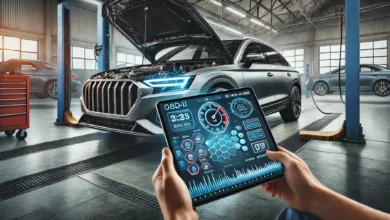The Rise of Autonomous Vehicles: What 2024 Holds for Self-Driving Cars
Introduction
Self-driving cars have been the talk of the automotive world for over a decade, but 2024 feels different. As we enter a new phase of technological innovation, autonomous vehicles are on the verge of becoming a normal part of our everyday lives. The progress made in recent years has been astonishing, driven by advances in artificial intelligence (AI), sensor technology, and machine learning. In 2024, the world stands at the cusp of a revolution in transportation, one where fully autonomous cars will not just be futuristic ideas but a reality on our roads.
In this article, we’ll explore the rapid growth of autonomous vehicles, what technological advancements have led us here, and what 2024 holds for this ever-evolving industry.
The Evolution of Self-Driving Technology
The journey toward self-driving cars began long before the shiny prototypes of today. The concept of vehicles driving themselves was once confined to the realms of science fiction. The roots of autonomous vehicle development can be traced back to early experiments in the 1980s, but it wasn’t until the 21st century that real progress began. As computing power increased, the integration of AI and sophisticated algorithms allowed vehicles to begin processing complex data and reacting in real time.
Over the years, each milestone—whether it was the introduction of advanced driver-assistance systems (ADAS) or breakthroughs in LiDAR and radar technology—has brought us closer to fully autonomous driving. Today, we’re looking at cars equipped with cutting-edge sensors, machine learning capabilities, and real-time data processing systems that can navigate streets with minimal human intervention.
Understanding Autonomous Vehicle Levels
To grasp where we are in 2024, it’s essential to understand the five levels of vehicle autonomy, ranging from Level 0 (no automation) to Level 5 (full autonomy). The progression through these levels marks the gradual evolution of driving technology:
- Level 0: No automation, all driving functions are performed by a human driver.
- Level 1: Basic driver assistance, such as cruise control or lane-keeping assist.
- Level 2: Partial automation, where the vehicle can control both steering and acceleration, but a human driver is still required to monitor the driving environment.
- Level 3: Conditional automation, where the vehicle can handle most driving tasks, but human intervention is necessary under certain conditions.
- Level 4: High automation, where the car can drive itself in specific scenarios without human intervention.
- Level 5: Full automation, where no human driver is required, and the vehicle can operate in all conditions.
As of 2024, most self-driving cars on the market operate at Level 3 or Level 4, with increasing progress toward full automation. The advances in technology are making Level 5 autonomy seem more attainable than ever.
How Autonomous Vehicles Work
At the heart of autonomous vehicles are complex systems that allow them to “see,” “think,” and “react.” These cars are equipped with an array of sensors, including cameras, radar, LiDAR, and ultrasonic sensors, that gather data about their surroundings. Much like human drivers rely on their senses, autonomous cars depend on these technologies to interpret their environment.
Once the data is collected, the vehicle’s AI-driven brain processes the information, makes decisions, and executes driving maneuvers. This process happens in real-time, with sophisticated algorithms ensuring that the car can adjust to changing road conditions, navigate around obstacles, and follow traffic rules. An additional layer of safety is provided by vehicle-to-everything (V2X) communication, where the car interacts with infrastructure, pedestrians, and other vehicles to enhance safety and efficiency.
2024: The Tipping Point for Self-Driving Cars
So, what does 2024 look like for self-driving cars? It’s a pivotal year, marking the transition from experimentation to mainstream adoption. The technology is not just limited to high-end experimental vehicles anymore; it’s being integrated into more affordable, consumer-level models, signaling a widespread shift.
In urban areas, self-driving cars are set to become more visible, with autonomous taxis and ride-hailing services playing a significant role. Cities with smart infrastructure are seeing more autonomous buses and delivery vehicles sharing the roads. While adoption rates in rural areas may be slower, 2024 represents a turning point in how we view personal and public transportation.
Key Technological Innovations in 2024
Technological innovation continues to be the backbone of autonomous vehicle development. In 2024, several key advancements are pushing self-driving cars closer to full autonomy. Enhanced sensors now offer more precise readings of the environment, even in adverse conditions like rain or fog. Processing systems have become faster, capable of analyzing vast amounts of data in real-time, allowing the car to respond almost instantaneously to changing situations.
Another exciting development is the increased efficiency of electric batteries, which is crucial as many autonomous vehicles are also electric. Longer battery life and faster charging times make it easier to incorporate self-driving technology into eco-friendly transportation models.
Autonomous Vehicles and Road Safety
One of the strongest arguments in favor of autonomous vehicles is their potential to improve road safety. Human error accounts for the vast majority of accidents, whether due to distractions, impaired driving, or simple mistakes. Autonomous cars, by contrast, are designed to avoid these pitfalls. With predictive analytics, real-time data processing, and advanced safety systems, self-driving cars are able to anticipate potential hazards and react faster than human drivers.
The reduction in human error is expected to lead to a significant drop in road accidents, saving lives and reducing the economic impact of crashes. Additionally, V2X communication allows vehicles to “talk” to each other, helping to avoid collisions and improve traffic flow.
The Role of AI and Machine Learning in 2024
AI and machine learning have transformed the capabilities of self-driving cars. In 2024, the learning systems used by autonomous vehicles are more advanced than ever. These systems continuously gather data from their environment, learning from each trip they make. This allows vehicles to improve their decision-making skills over time, becoming safer and more efficient the more they drive.
Machine learning algorithms also play a vital role in route planning and navigation. By analyzing traffic patterns, weather conditions, and other variables, self-driving cars can optimize routes, reduce travel time, and minimize energy consumption.
Environmental Impact of Autonomous Vehicles
The environmental benefits of autonomous vehicles are significant. With the potential to reduce the number of vehicles on the road through car-sharing and ride-hailing services, fewer emissions are released into the atmosphere. Autonomous cars, especially those that are electric, contribute to cleaner cities and reduced air pollution.
Moreover, the efficiency of autonomous vehicles means they consume less fuel or energy. Their ability to optimize routes and maintain steady speeds results in lower fuel consumption, which is a win for both the environment and drivers.
Infrastructure Changes to Support Autonomous Vehicles
For autonomous vehicles to reach their full potential, infrastructure must evolve alongside them. In 2024, many cities are investing in smart infrastructure, including roads, traffic lights, and signage that can communicate with self-driving cars. These upgrades make it easier for autonomous vehicles to navigate urban environments safely and efficiently.
Vehicle-to-infrastructure (V2I) communication plays a crucial role here. By allowing cars to receive real-time updates from traffic systems, they can adjust their speed, change lanes, or reroute to avoid congestion, making travel smoother and faster.
Legal and Regulatory Challenges in 2024
As self-driving technology advances, so too must the legal framework that governs it. In 2024, regulatory bodies are working to update laws to ensure the safe deployment of autonomous vehicles. Issues such as liability in the event of an accident, data privacy, and ethical decision-making are all being debated by lawmakers.
Governments must balance the need for innovation with public safety concerns. The establishment of clear guidelines will be essential for the continued growth of the autonomous vehicle industry.
Public Perception and Acceptance of Self-Driving Cars
Public opinion about self-driving cars has shifted dramatically over the years. In 2024, more people are becoming comfortable with the idea of sharing the road with autonomous vehicles. However, concerns remain, particularly about job losses in driving professions and the safety of autonomous technology.
Education and transparency will be key to increasing public trust. As more people experience the convenience and safety of self-driving cars, acceptance is likely to grow.
The Economic Impact of Autonomous Vehicles
The rise of autonomous vehicles is not just changing how we drive; it’s also reshaping the economy. The introduction of new jobs in technology, infrastructure maintenance, and vehicle manufacturing will help offset the potential loss of jobs in driving industries. Additionally, the efficiency of self-driving cars will reduce costs in logistics and transportation, benefiting businesses and consumers alike.
In the long term, the economic benefits of autonomous vehicles could be immense, leading to increased productivity, lower transportation costs, and fewer resources spent on accident-related expenses.
Autonomous Vehicles in Public Transportation
In 2024, autonomous technology is making its mark on public transportation. Autonomous buses, shuttles, and even trains are being deployed in several cities, offering a glimpse into the future of mass transit. These vehicles are not only more efficient but also help reduce traffic congestion and emissions.
Public transportation systems are adapting to this shift by upgrading their infrastructure and ensuring that their services are compatible with autonomous vehicles. This transition is expected to improve the overall public transit experience while reducing the number of privately-owned cars on the road.
The Future of Personal Ownership vs. Autonomous Fleets
One of the most intriguing questions about autonomous vehicles is whether people will still own cars in the future. With the rise of autonomous fleets and car-sharing services, some experts predict a shift away from personal ownership. In 2024, we’re seeing the early stages of this transition, with more people opting for ride-hailing services rather than buying their own vehicles.
Subscription models, where users pay a monthly fee to access a fleet of autonomous cars, are also gaining traction. This shift could lead to a future where owning a car becomes less of a necessity and more of a luxury.
Ethical Considerations for Autonomous Vehicles
The ethical implications of self-driving technology continue to be a topic of debate. One of the most challenging dilemmas involves the decision-making process in life-or-death situations. How should a car’s AI react if an accident is unavoidable? Should it prioritize the safety of its passengers or pedestrians?
Privacy is another concern, as autonomous vehicles collect vast amounts of data on their passengers and surroundings. Ensuring that this data is used ethically and securely is essential for maintaining public trust in the technology.
Autonomous Vehicles and Insurance
The insurance industry is undergoing a transformation as autonomous vehicles become more common. Traditional models, where the driver is held responsible for accidents, are being challenged. In the case of self-driving cars, determining liability is more complex. Is the car manufacturer responsible? Or the software developer?
In 2024, insurers are beginning to adapt to these changes, offering new policies that take into account the unique risks associated with autonomous vehicles. As technology advances, the need for innovative insurance solutions will only grow.
Autonomous Vehicles and Accessibility
One of the most exciting aspects of autonomous vehicles is their potential to provide greater accessibility for people who are unable to drive. In 2024, self-driving cars are helping the elderly, disabled, and those with vision impairments gain independence. Autonomous vehicles can offer mobility to individuals who previously relied on others for transportation, enhancing their quality of life.
The ability to summon a self-driving car with the press of a button opens up new possibilities for inclusive transportation, making cities more accessible for everyone.
Autonomous Vehicles in Rural and Remote Areas
While much of the focus has been on urban environments, autonomous vehicles also have the potential to transform rural areas. In 2024, efforts are underway to extend autonomous technology to remote communities. These areas often lack public transportation options, and self-driving vehicles could offer a solution.
However, rural adoption faces challenges such as limited infrastructure and connectivity. Despite these obstacles, the expansion of autonomous vehicles into these areas could spur economic growth and improve access to essential services.
Conclusion
The rise of autonomous vehicles in 2024 marks a significant turning point in transportation history. From technological innovations and safety improvements to environmental benefits and economic opportunities, self-driving cars are poised to reshape the way we move through the world. While challenges remain, the future looks bright for autonomous vehicles. As we look ahead, it’s clear that this technology will continue to evolve, bringing us closer to a world where self-driving cars are the norm rather than the exception.


